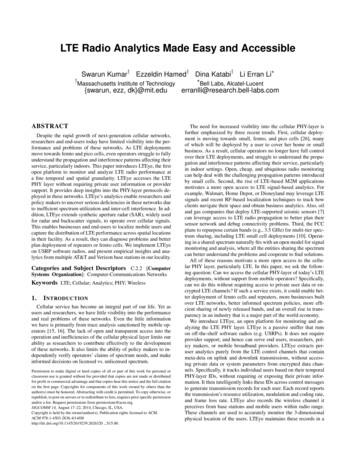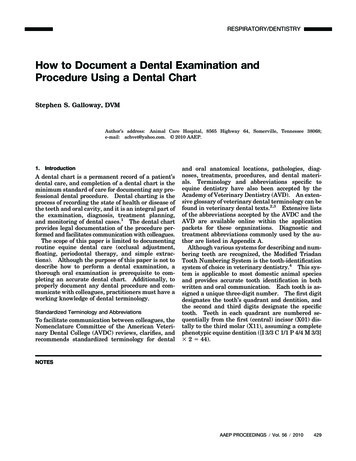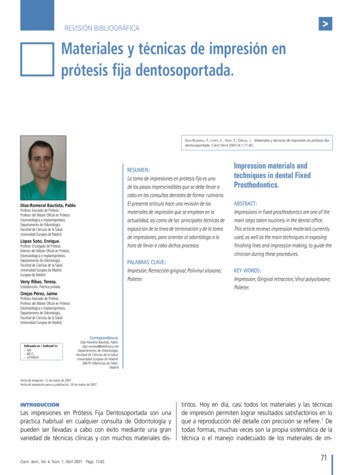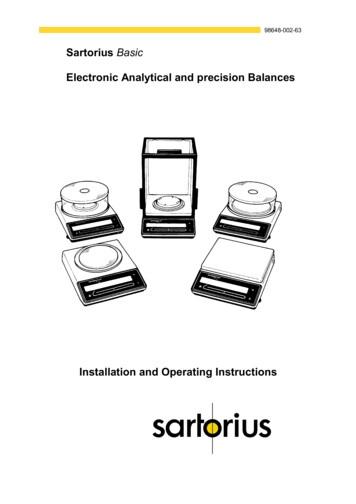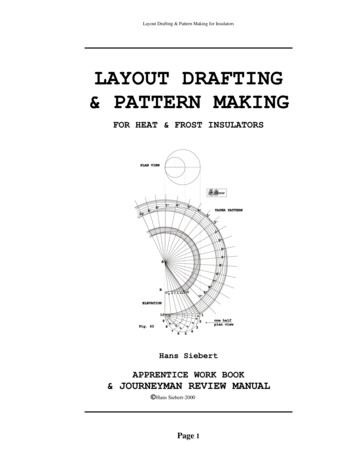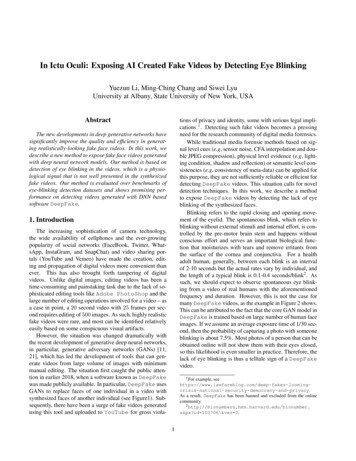
Transcription
In Ictu Oculi: Exposing AI Created Fake Videos by Detecting Eye BlinkingYuezun Li, Ming-Ching Chang and Siwei LyuUniversity at Albany, State University of New York, USAAbstracttions of privacy and identity, some with serious legal implications 1 . Detecting such fake videos becomes a pressingneed for the research community of digital media forensics.While traditional media forensic methods based on signal level cues (e.g, sensor noise, CFA interpolation and double JPEG compression), physical level evidence (e.g, lighting condition, shadow and reflection) or semantic level consistencies (e.g, consistency of meta-data) can be applied forthis purpose, they are not sufficiently reliable or efficient fordetecting DeepFake videos. This situation calls for noveldetection techniques. In this work, we describe a methodto expose DeepFake videos by detecting the lack of eyeblinking of the synthesized faces.Blinking refers to the rapid closing and opening movement of the eyelid. The spontaneous blink, which refers toblinking without external stimuli and internal effort, is controlled by the pre-motor brain stem and happens withoutconscious effort and serves an important biological function that moisturizes with tears and remove irritants fromthe surface of the cornea and conjunctiva. For a healthadult human, generally, between each blink is an intervalof 2-10 seconds but the actual rates vary by individual, andthe length of a typical blink is 0.1-0.4 seconds/blink2 . Assuch, we should expect to observe spontaneous eye blinking from a video of real humans with the aforementionedfrequency and duration. However, this is not the case formany DeepFake videos, as the example in Figure 2 shows.This can be attributed to the fact that the core GAN model inDeepFake is trained based on large number of human faceimages. If we assume an average exposure time of 1/30 second, then the probability of capturing a photo with someoneblinking is about 7.5%. Most photos of a person that can beobtained online will not show them with their eyes closed,so this likelihood is even smaller in practice. Therefore, thelack of eye blinking is thus a telltale sign of a DeepFakevideo.The new developments in deep generative networks havesignificantly improve the quality and efficiency in generating realistically-looking fake face videos. In this work, wedescribe a new method to expose fake face videos generatedwith deep neural network models. Our method is based ondetection of eye blinking in the videos, which is a physiological signal that is not well presented in the synthesizedfake videos. Our method is evaluated over benchmarks ofeye-blinking detection datasets and shows promising performance on detecting videos generated with DNN basedsoftware DeepFake.1. IntroductionThe increasing sophistication of camera technology,the wide availability of cellphones and the ever-growingpopularity of social networks (FaceBook, Twitter, WhatsApp, InstaGram, and SnapChat) and video sharing portals (YouTube and Vemeo) have made the creation, editing and propagation of digital videos more convenient thanever. This has also brought forth tampering of digitalvideos. Unlike digital images, editing videos has been atime-consuming and painstaking task due to the lack of sophisticated editing tools like Adobe PhotoShop and thelarge number of editing operations involved for a video – asa case in point, a 20 second video with 25 frames per second requires editing of 500 images. As such, highly realisticfake videos were rare, and most can be identified relativelyeasily based on some conspicuous visual artifacts.However, the situation was changed dramatically withthe recent development of generative deep neural networks,in particular, generative adversary networks (GANs) [11,21], which has led the development of tools that can generate videos from large volume of images with minimummanual editing. The situation first caught the public attention in earlier 2018, when a software known as DeepFakewas made publicly available. In particular, DeepFake usesGANs to replace faces of one individual in a video withsynthesized faces of another individual (see Figure1). Subsequently, there have been a surge of fake videos generatedusing this tool and uploaded to YouTube for gross viola-1 For example, risis-national-security-democracy-and-privacy.As a result, DeepFake has been banned and excluded from the onlinecommunity.2 d 100706\&ver 0.1
Our method uses a deep neural network model that combines CNN and recursive neural network, known as longterm recurrent CNN (LRCN) [7], to distinguish open andclose eye states with the consideration of previous temporal knowledge. Our method is evaluated over benchmarks of eye-blinking detection datasets and also showpromising performance on detecting videos generated withDeepFake.2. Related Works2.1. AI Generation of Fake VideosPreviously, realistic images/videos were generated using detailed 3D computer graphics models. Recently, thedevelopment of new deep learning algorithms, especiallythose based on the generative adversarial networks (GANs).Goodfellow et al. [11] first proposed generative adversarialnetworks (GANs), which typically consist of two networks:the generator network and the discriminator network. Thegenerator aims to produce an image that cannot be distinguished from training images, while the discriminator differentiates training images from images synthesized by thegenerator network. The two networks are trained in tandemwith the generator and the discriminator competing witheach other – the generator tries to create images that canconfuse the discriminator, while the discriminator tries toclassify the synthetic images from the real training images.Subsequently, many general image synthesis or face synthesis works have been proposed based on the idea ofGANs. Denton et al. [5] proposed a Laplacian pyramidGAN to generate images in a coarse-to-fine fashion. Radford et al. [24] proposed deep convolutional GANs (DCGAN) and showed the potential for unsupervised learning.Arjovsky et al. [1] used Wasserstein distance to make training stable. Isola et al. [15] investigated conditional adversarial networks to learn mapping from input image to output image and also the loss function to train the mapping.Taigman et al. [32] proposed the domain transfer network(DTN) to map a sample from one domain to an analogoussample in another domain and achieved favorable performance on small resolution face and digit images. Shrivastava et al. [25] reduced the gap between synthetic and realimage distribution using a combination of the adversarialloss and the self-regularization loss. Liu et al. [21] proposed an unsupervised image to image translation framework based on coupled GANs, which aims to learn the jointrepresentation of images in different domains. This algorithm is the basis for the DeepFake algorithm , the processof which is given in Figure 1.2.2. Eye Blinking DetectionDetecting eye blinking has previously been studied incomputer visions for applications in fatigue detection [14,34, 8, 2, 22] and face spoof detection [4, 10, 20, 30, 19]. Panet al. [23] constructed undirected conditional random fieldframework to infer eye closeness such that eye blinking isdetected. Sukno et al. [31] employed active shape modelswith invariant optimal features to delineate the outline ofeyes and computed the eye vertical distance to decide eyestate. Torricelli et al. [33] utilized the difference betweenconsecutive frames to analyze state of eyes. Divjak et al.[6] employed optical flow to obtain eye movement and extract the dominant vertical eye movement for blinking analysis. Yang et al. [35] modeled the shape of eyes based on apair of parameterized parabolic curves, and fit the model ineach frame to track eyelid. Drutarovsky et al. [9] analyzedthe variance of the vertical motions of eye region which isdetected by a Viola-Jones type algorithm. Then a flock ofKLT trackers are used on the eye region. Each eye region isdivided into 3x3 cells and an average motion in each cell iscalculated. Soukupova et al. [28] proposed a scalar quantitythat measures the aspect ratio of the rectangular boundingbox of an eye (eye aspect ratio – EAR) corresponding to theeye openness degree in each frame. They then trained anSVM of EARs within a short time window to classify finaleye state. Kim et al. [16] studied CNN-based classifiers todetect eye open and close state. To date, we are not awareof deep NN based eye blinking detection algorithms.3. MethodIn this section, we describe in detail our method to detecteye blinking in a video. We extend the work on CNN-basedclassifier to LRCN [7], which incorporates the temporal relationship between consecutive frames, as eye blinking is atemporal process which is from opening to closed, such thatLRCN can memorize the long term dynamics to remedy theeffect by artifacts introduced from single image. The general overview of our algorithm is provided in Figure 2.3.1. Pre-processingThe first step in our method is to locate the face areas ineach frame of the video using a face detector. Then faciallandmarks, which are locations on the face carrying important structural information such as tip of the eyes, noses andmouths and contours of the cheek, are extracted from eachdetected face area.The head movement and changes in face orientation inthe video frames introduce distractions in facial analysis.As such, we first align the face regions to a unified coordinate space using landmark based face alignment algorithms.Specifically, given a set of face landmarks in original coordinate, 2D face alignment is to warp and transform the image to another coordinate space, where the transformed faceis (1) in the center of image, (2) rotated to make eyes lie ona horizontal line and (3) scaled to a similar size.From the aligned face areas, we can extract a surrounding rectangular regions of the landmarks corresponding to
nFacedetectionAffinewarp (g)(h)(i)(e)(f)Figure 1. Overview of fake face generation. (a) The original input image. The green dash box in (b) is the face area localized by facedetector. (c) Detected face landmarks. (d) Face after alignment. DeepFake takes (d) as input and convert it to (g). The artifacts areintroduced by directly affine warping generated face back to (a), as shown in (f, e). (h) The convex polygon mask that generated face insideis retained. (i) Smoothed boundary of mask. (j) The final fake image.(c)Time:Eye sequence(a)FeatureextractionCNN CNNCNNCNN CNNp1 p2 p3p6 p5 TMLSTMFCFCFCFCFC00100Figure 2. Overview of our LRCN method. (a) is the original sequence. (b) is the sequence after face alignment. We crop out eye regionof each frame based on eye landmarks p1 6 in (b) and pass it to (c) LRCN, which consists of three parts: feature extraction, sequencelearning and state prediction.the contours of the eyes into a new sequence of inputframes, see Figure 2(b). Specifically, the rectangle regionis generated by first extracting the bounding boxes of eacheye’s landmark points, then scaling the bounding box by1.25 in the horizontal direction and 1.75 in the vertical direction, respectively, to ensure that the eye region is included in the cropped region. The cropped eye area sequences are passed into LRCN for dynamic state prediction.3.2. Long-Term Recurrent CNNsAs human eye blinking shows strong temporal dependencies, we employ the long-term recurrent convolutionalneural networks (LRCN) model [7] to capture such temporal dependencies. As shown in Figure 2(c), the LRCNmodel is composed by three parts, namely, feature extraction, sequence learning and state prediction. Feature extraction module converts the input eye region into discriminative features. It is implemented with a ConvolutionalNeural Network (CNN) based on the VGG16 framework[26] but without fc7 and fc8 layers3 . VGG16 is composed by five blocks of consecutive convolutional layersconv1 5, where max-pooling operation follows eachblock. Then three fully connected layers fc6 8 areappended on the last block. The output from the featureextraction is fed into sequence learning, which is implemented with a recursive neural network (RNN) with LongShort Term Memory (LSTM) cells [13]. The use of LSTMRNN is to increase the memory capacity of the RNN modeland avoid the gradient vanishing in the back-propagationthrough-time (BPTT) algorithm in the training phase.3.3. LSTM-RNNLSTMs are memory units that control when and how toforget previous hidden states and when and how to update3 Other deep CNN architecture such as ResNet [12] can also be usedbut for simplicity we choose VGG16 in the current work.
4. Experimentsht z tC t 1Ct We train the LRCN model based on image datasets ofeye open states. We then test the algorithm detecting eyeblinking on authentic and fake videos generated with theDeepFake algorithm.tanhσσσtanhht 1ht4.1. DatasetsxtFigure 3. A diagram of LSTM structure.hidden states [13]. We use LSTM as illustrated in Figure3, where σ(x) 1 e1 x is sigmoid function to push inputx xinto [0, 1] range, tanh(x) eex e e x is hyperbolic tangentfunction which squash input into [ 1, 1] range, denotesinner product of two vectors. Given input Ct 1 , ht 1 , xt ,the LSMT updates along with time t byft σ(Wf h ht 1 Wf x xt bf )it σ(Wih ht 1 Wix xt bi )gt tanh(Wch ht 1 Wcx xt bc )Ct ft Ct 1 it gtot σ(Woh ht 1 Wox xt bo )ht ot tanh(Ct )(1)where ft is forget gate to control what previous memorieswill be discard, it is input gate to selectively pass the currentinput, which is manipulated by gt . ot is output gate to control how much memory will be transferred into hidden stateht . Memory cell Ct is combined by previous memory cellCt 1 controlled by ft and manipulated input gt controlledby it . We use 256 hidden units in LSTM cell, which is thedimension of LSTM output zt .For the final state prediction stage, the output of eachRNN neuron is further sent to neural network consists of afully connected layer, which takes the output of LSTM andgenerate the probability of eye open and close state, denotedby 0 and 1 respectively.3.4. Model TrainingThe training of the LRCN model is performed in twosteps. In the first step, we train the VGG based CNN modelusing a set of labeled training data consisting of eye regions corresponding to open and closed eyes. The model istrained using back-propagation implemented with stochastic gradient descent with dropout [29] in fully connectedlayers. In the second step, the LSTM-RNN and fully connected part of the network are trained jointly using the backpropagation-through-time (BPTT) algorithm. In both cases,the loss objective is cross entropy loss with binary classes(open or closed). Implementation details are given in thenext section.To date, there are a few image datasets that can be usedfor evaluating algorithms that detect closed eyes, such asthe CEW Dataset [27]4 , which includes 1, 193 images ofclosed eyes and 1, 232 images of open eyes. However, noexisting video dataset specially designed for the same purpose is available, which is important due to the temporalnature of eye blinking.To be able to experimentally evaluate our algorithm, wedownloaded 50 videos, where each represents one individual and lasts approximate 30 seconds with at least one blinking occurred, to form the eye blinking video (EBV) dataset.We annotate the left and right eye states of each frame ofthe videos using an annotation tool we developed5 . In ourexperiments, we select 40 videos as our training set for theoverall LRCN model and 10 videos as the testing set. Weuse the CEW dataset together with our training set to trainthe front-end CNN model.Furthermore, we use DeepFake with post-processingto generate fake face videos, see Figure 1. Specifically, wefirst use dlib to detect face area in each image. Then facelandmarks are extracted for face alignment as described insection 3. We then generate the corresponding fake facesusing the DeepFake algorithm. If we directly affine warpthis rectangle of fake face back to image using similaritytransformation matrix, the boundary of rectangle is visiblein most cases as the slight color difference of real and fakeface area, as shown in Figure 1(e). To reduce such artifacts,we generate a specific mask which is a convex polygon determined by landmarks of left and right eyebrow, and thebottom mouth. As such, we only retain content inside thismask after affine warping fake face back to original image.To further smooth the transformation, we apply Gaussianblur to the boundary of mask. We collect interview and presentation episodes from web and generated 49 such fakevideos in total.4.1.1Data preparationFace detection, landmark extraction and face alignment areimplemented based on library dlib [17], which integrates4 Downloaded from ases.html. The other dataset, the EEGEye State Data Set https://archive.ics.uci.edu/ml/datasets/EEG Eye State, is not available to download. Similarly,the ZJU Eyeblink Video Database [23] is not accessible.5 Our dataset and annotation tool will be made available to downloadafter the reviewer period.
Table 1. Performance of our method on collected original videosand corresponding fake videos.VideoOriginFakeFigure 4. Illustration of ROC curve for CNN, LRCN and EAR.the current state-of-the-art face analysis algorithms. Wegenerate eye sequences by cropping out eye area of eachframe of our video dataset.We augment data to increase training robustness. Thetraining of the front-end CNN model takes images as input,so we use each frame of generated eye sequences as training sample, with additional augmentation: horizontal flipping image, modifying image color contrast, brightness andcolor distortion. For LRCN joint training, eye sequencesare required. In particular, the augmentation process for sequence should be consistent to avoid affect temporal relationship, such that the process for each frame in sequenceshould be same.With combination of our cropped eye images and CEWdataset, we train VGG16 as a binary image classifier to distinguish eye state in image domain. The input size is fixedas 224x224 and the batch size is 16. The learning rate startsfrom 0.01 and decays by 0.9 each 2 epochs. We employstochastic gradient descent optimizer and terminate training until it reaches the maximum epoch number 100. Thenwe remove fc7, fc8 layers from trained VGG16 to be thefeature extraction part of LRCN.We randomly select a sequence which contains a variety of temporal consecutive eye images with at least oneblinking occurred as LRCN input. Each sample has variable length between 10 to 20 images. We fix the parametersof CNN layers we obtain above and perform training onrest part: LSTM cells and fc layer. We set batch size as4. The learning rate starts from 0.01 and decay by 0.9 each2 epochs. We use the ADAM optimizer [18] and terminatetraining until 100 epochs.4.2. EvaluationsWe evaluate our LRCN method with comparison to othermethods: the eye aspect ratio (EAR) based method [28] anda CNN-based method. The EAR-based method replies oneye landmarks to analyze eye state, in terms of the ratiobetween the distance of upper and lower eyelid, and thedistance between left and right corner point, which is de6 k kp3 p5 kfined as EAR kp2 p, where pi (i 1, · · · , 6)2kp1 p4 kAverage video length10 seconds10 secondsFPS3030Rate of blinks34.1 / min3.4 / mincorrespond to the landmark points of an eye (see Figure2(b)). The EAR-based method runs fast as the computationof EAR is simple. However, the main drawback of EARmethod is that it fully depends on eye landmarks, whichcannot be reliably detected in many practical videos. CNNimage classifier is trained on image domain to distinguishdifferent classes. We employ VGG16 as our CNN modelto distinguish eye state. The problem with the CNN basedmethod is that it cannot take into consideration of the temporal consistency during eye blinking.We evaluate these three methods on the test videos with32 blinking events. Figure 4 illustrate the ROC curve ofthree methods. Note that LRCN show the best performance0.99 compared to CNN 0.98 and EAR 0.79 in terms of thearea under ROC (AUC). CNN-based method shows a goodperformance to distinguish the eye state on image domain,but it can be further improved with LRCN, which considerslong term dynamics to effectively predict eye state. A comparison is shown in Figure 5. When the actual eye area issmall, CNN-based model using only image input is ineffective, while LRCN using temporal correlation can correctlypredict.We set 0.5 as threshold to distinguish eye open and closestate. We define a blink as a peak above threshold 0.5 withduration less than 7 frames. Table 1 shows the performanceof our method on 49 collected videos and corresponding49 fake videos generated using DeepFake, as in Figure1. Rate of blinks is the number of detected blinks per 60seconds. We can detect 34.1/min blinks in original videos6, whereas only 3.4/min blinks is detected in fake videos. Ifwe set the average blinking rate of a normal human being to10/min [3], then all DeepFake generated videos are belowthis standard. One visual example is shown in Figure 6, withmore examples provided in the supplementary materials.5. ConclusionThe new developments in deep generative networks havesignificantly improve the quality and efficiency in generating realistically-looking fake face videos. In this work, wedescribe a new method to expose fake face videos generated with deep neural networks. Our method is based ondetection of eye blinking in the videos, which is a physiological signal that is not well presented in the synthesizedfake videos. Our method is tested over benchmarks of eyeblinking detection datasets and also show promising perfor6 As the collected videos are mainly interview/presentation episodes,the rate of blink is a bit higher than normal case.
CNN#13010OriginalprobabilityLRCN#2710SecondsFigure 5. Illustration of comparing CNN and LRCN on left eye of Trump video. LRCN exhibits more smooth and accurate results thanCNN, e.g, if blinking has just occurred, the eyes in next couple frames are likely to be open (frame #139). If there is no trend of eye closingbefore, the eye state of next frame is likely to be open (frame abilityFakeProbabilityOriginal#1510SecondsFigure 6. Example of eye blinking detection on an original video (top) and a DeepFake generated fake video (bottom). Note that in theformer, an eye blinking can be detected within 6 seconds, while none is detected in the latter.mance on detecting videos generated with the DNN-basedsoftware DeepFake.There are several directions that we would like to further improve the current work. First, we will explore otherdeep neural network architectures for more effective methods to detect closed eyes. Second, our current method onlyuses the lack of blinking as a cue for detection. However,the dynamic pattern of blinking should also be considered– too frequent blinking that is deemed physiologically unlikely could also be a sign of tampering. Finally, eye blink-ing is a relatively easy cue in detecting fake face videos,and sophisticated forgers can still create realistic blinkingeffects with post-processing and advanced models trainedwith more data. Therefore, we will continue explore othertypes of physiological signals that are intrinsic to a live human but ignored in the AI synthesis methods.Acknowledgement. This material is based upon work supported by the United States Air Force Research Laboratory (AFRL) and the Defense Advanced Research ProjectsAgency (DARPA) under Contract No. FA8750-16-C-0166.
References[1] M. Arjovsky, S. Chintala, and L. Bottou. Wasserstein gan.arXiv preprint arXiv:1701.07875, 2017.[2] T. Azim, M. A. Jaffar, and A. M. Mirza. Fully automatedreal time fatigue detection of drivers through fuzzy expertsystems. Applied Soft Computing, 18:25–38, 2014.[3] A. R. Bentivoglio, S. B. Bressman, E. Cassetta, D. Carretta,P. Tonali, and A. Albanese. Analysis of blink rate patternsin normal subjects. Movement Disorders, 12(6):1028–1034,1997.[4] Z. Boulkenafet, J. Komulainen, and A. Hadid. Face antispoofing based on color texture analysis. In ICIP, pages2636–2640, 2015.[5] E. L. Denton, S. Chintala, R. Fergus, et al. Deep generative image models using a laplacian pyramid of adversarialnetworks. In Advances in neural information processing systems, pages 1486–1494, 2015.[6] M. Divjak and H. Bischof. Eye blink based fatigue detectionfor prevention of computer vision syndrome. In MVA, pages350–353, 2009.[7] J. Donahue, L. Anne Hendricks, S. Guadarrama,M. Rohrbach, S. Venugopalan, K. Saenko, and T. Darrell. Long-term recurrent convolutional networks for visualrecognition and description. In CVPR, pages 2625–2634,2015.[8] W. Dong and X. Wu. Fatigue detection based on the distanceof eyelid. In International Workshop on VLSI Design andVideo Technology, pages 365–368, 2005.[9] T. Drutarovsky and A. Fogelton. Eye blink detection usingvariance of motion vectors. In ECCV, pages 436–448, 2014.[10] J. Galbally and S. Marcel. Face anti-spoofing based on general image quality assessment. In ICPR, pages 1173–1178,2014.[11] I. Goodfellow, J. Pouget-Abadie, M. Mirza, B. Xu,D. Warde-Farley, S. Ozair, A. Courville, and Y. Bengio. Generative adversarial nets. In Advances in neural informationprocessing systems, pages 2672–2680, 2014.[12] K. He, X. Zhang, S. Ren, and J. Sun. Deep residual learningfor image recognition. In CVPR, pages 770–778, 2016.[13] S. Hochreiter and J. Schmidhuber. Long short-term memory.Neural Comput., 9(8):1735–1780, 1997.[14] W.-B. Horng, C.-Y. Chen, Y. Chang, and C.-H. Fan. Driverfatigue detection based on eye tracking and dynamk, template matching. In International Conference on Networking,Sensing and Control, volume 1, pages 7–12, 2004.[15] P. Isola, J.-Y. Zhu, T. Zhou, and A. A. Efros. Imageto-image translation with conditional adversarial networks.arXiv preprint, 2017.[16] K. W. Kim, H. G. Hong, G. P. Nam, and K. R. Park. A studyof deep cnn-based classification of open and closed eyes using a visible light camera sensor. Sensors, 17(7):1534, 2017.[17] D. E. King. Dlib-ml: A machine learning toolkit. JMLR,10:1755–1758, 2009.[18] D. P. Kingma and J. Ba. Adam: A method for stochasticoptimization. arXiv preprint arXiv:1412.6980, 2014.[19] H. Li, P. He, S. Wang, A. Rocha, X. Jiang, and A. C. Kot.Learning generalized deep feature representation for faceanti-spoofing. TIFS, 13(10):2639–2652, 2018.[20] L. Li, X. Feng, X. Jiang, Z. Xia, and A. Hadid. Face antispoofing via deep local binary patterns. In ICIP, pages 101–105, 2017.[21] M.-Y. Liu, T. Breuel, and J. Kautz. Unsupervised image-toimage translation networks. In NIPS, pages 700–708, 2017.[22] B. Mandal, L. Li, G. S. Wang, and J. Lin. Towards detection of bus driver fatigue based on robust visual analysis ofeye state. IEEE Transactions on Intelligent TransportationSystems, 18(3):545–557, 2017.[23] G. Pan, L. Sun, Z. Wu, and S. Lao. Eyeblink-based antispoofing in face recognition from a generic webcamera. InICCV, pages 1–8, 2007.[24] A. Radford, L. Metz, and S. Chintala. Unsupervised representation learning with deep convolutional generative adversarial networks. arXiv preprint arXiv:1511.06434, 2015.[25] A. Shrivastava, T. Pfister, O. Tuzel, J. Susskind, W. Wang,and R. Webb. Learning from simulated and unsupervisedimages through adversarial training. In CVPR, volume 3,page 6, 2017.[26] K. Simonyan and A. Zisserman. Very deep convolutionalnetworks for large-scale image recognition. arXiv preprintarXiv:1409.1556, 2014.[27] F. Song, X. Tan, X. Liu, and S. Chen. Eyes closeness detection from still images with multi-scale histograms of principal oriented gradients. Pattern Recognition, 47(9):2825–2838, 2014.[28] T. Soukupova and J. Cech. Real-time eye blink detection using facial landmarks. In 21st Computer Vision Winter Workshop, pages 1–8, 2016.[29] N. Srivastava, G. Hinton, A. Krizhevsky, I. Sutskever, andR. Salakhutdinov. Dropout: A simple way to prevent neural networks from overfitting. Journal of Machine LearningResearch, 15:1929–1958, 2014.[30] H. Steiner, A. Kolb, and N. Jung. Reliable face anti-spoofingusing multispectral swir imaging. In ICB, pages 1–8, 2016.[31] F. M. Sukno, S.-K. Pavani, C. Butakoff, and A. F. Frangi.Automatic assessment of eye blinking patterns through statistical shape models. In International Conference on Computer Vision Systems, pages 33–42, 2009.[32] Y. Taigman, A. Polyak, and L. Wolf. Unsupervised crossdomain image generation. arXiv preprint arXiv:1611.02200,2016.[33] D. Torricelli, M. Goffredo, S. Conforto, and M. Schmid.An adaptive blink detector to initialize and update a viewbasedremote eye gaze tracking system in a natural scenario.Pattern Recognition Letters, 30(12):1144–1150, 2009.[34] Q. Wang, J. Yang, M. Ren, and Y. Zheng. Driver fatigue detection: a survey. In The Sixth World Congress on IntelligentControl and Automation, volume 2, pages 8587–8591, 2006.[35] F. Yang, X. Yu, J. Huang, P. Yang, and D. Metaxas. Robusteyelid tracking for fatigue detection. In ICIP, pages 1829–1832, 2012.
videos. Unlike digital images, editing videos has been a time-consuming and painstaking task due to the lack of so-phisticated editing tools like Adobe PhotoShop and the large number of editing operations involved for a video – as a case in point, a 20 second video with 25 frames per sec-ond requires
